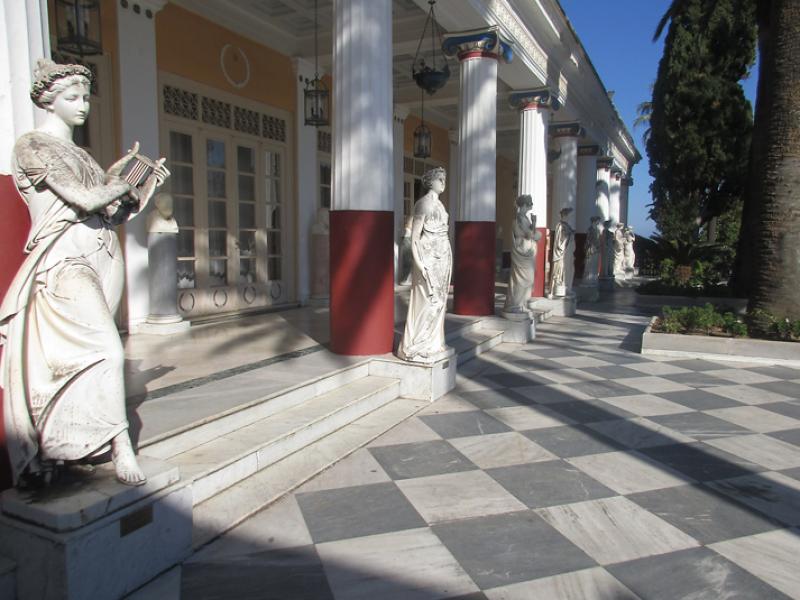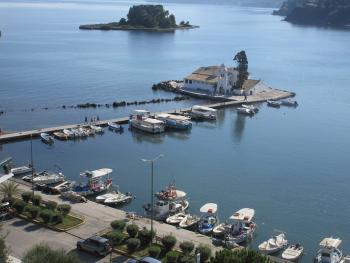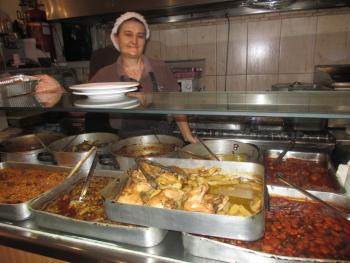At their own pace in Corfu and northern Greece
This item appears on page 22 of the September 2020 issue.
On previous trips to Greece, my wife, Carole, and I had explored the island of Crete, the city of Athens and several Mediterranean islands in the southern part of the country, so during our 2019 trip, we headed for northern Greece looking for new adventures.
From Chania, Crete, on Oct. 21 we flew via Athens to the island of CORFU (Kerkyra in Greek) in the Ionian Sea. Off the northwest coast of the Greek mainland, it’s almost a stone’s throw from southern Albania.
We planned on spending several days in Corfu so decided to stay in a private apartment. For about €50 (near $59) a night, we booked one on Airbnb.com that was in a residential neighborhood and close to transport, providing us (almost) all the comforts of home and allowing us to meet the locals.
Corfu presented many surprises as we struck out on our own for sightseeing. Initially, we took a leisurely stroll to the elegant Old Town, stopping for lunch and coffee at Pane e Souvlaki (panesouvlaki.com), where we spent about €20 for both of us as vast numbers of tourists arrived from six huge cruise ships. We ate there more than once.
Fortunately, most locals spoke English, even though Carole resurrected enough of her limited Greek to be polite to the Corfiotes.
With unlimited all-day (public) Blue Bus passes (€5 each), we darted all over the Corfu Town vicinity, seeing stunning beach resort areas, traditional mountain villages and the splendid Achilleion Palace (entry, with audio guide, €8), featuring breathtaking gardens with magnificent views.
We had no idea there had been such a close connection between Austria’s Empress Elisabeth (Sisi) and, later, Germany’s Kaiser Wilhelm II and Corfu’s palace. Not even the hordes of tourists at the palace could detract from this spectacular attraction.
We concluded a full day of sightseeing with cool drinks at a lovely café overlooking the turquoise Ionian Sea waters and the small church of Panagia Vlacherna on Pontikonisi (Mouse Island), while planes landed right before our eyes at the airport below us. Gorgeous!
Next we hit the picturesque resort area of Paleokastritsa on the island’s west coast, with its clear turquoise waters and rocky beach filled with topless “bathers.”
We liked the Greek mezes and coffee the best at the beachside Xenia restaurant (phone +30 2663 041208), where we spent around €12 for the two of us.
We wanted to extend our Corfu stay, but with a major Greek national holiday weekend impending (Oct. 28 is known as Oxi [“No”] Day, marking Greece’s defiance of Mussolini in 1940), we had to move from our Airbnb. Fortunately, we found the elegant Cavalieri Hotel, formerly a 17th-century nobleman’s mansion in Old Town, which we booked on Expedia.com for about €70 a night (with breakfast), with splendid seaside views.
This gave us a different part of the myriad streets and alleys of Old Town to explore — in superb weather — including Corfu’s lovingly restored historic synagogue, which lost almost all its congregants to the Nazis in World War II.
A “must see” was the Old Fortress, which, dating back to the 6th century, has seen Corfu’s many occupants for centuries — Byzantine, Venetian, Ottoman, British, French, German, etc. — all of whom influenced life there. Fascinating! We climbed to the flagpole at the very top for amazing views.
Everywhere, we could relax in sidewalk cafés, frequently sipping coffee, enjoying cool drinks and magnificent views and dining deliciously. The Liston Café Restaurant (10 Plateia Eleftherias; www.facebook.com/listoncafe) was especially lovely. The REX Restaurant (Kapodistriou 66; rexrestaurant.gr), at about €30 for the two of us, was particularly good. Also good was Pane e Psaraki (www.facebook.com/panepsaraki), where we spent about €20.
After a week on magnificent Corfu, it was time to leave for discoveries in northern Greece.
The 4-hour ferry-and-bus journey from Corfu Island to IOANNINA, in Greece’s interior, was splendid — gliding past majestic islands by boat and passing through countless tunneled mountains on good roads. However, the best part was the friendly and helpful Greek fellow passengers. These special new acquaintances even gave us warm hugs when we got off the bus in Ioannina, a bustling and interesting city.
Why Ioannina? We were looking for a good midway stopping point between Corfu and Thessaloniki, and locals had told us what a lovely and vibrant small city it is. A university town, it’s set on a beautiful lake.
We arrived on “No” Day, and the streets, bars and cafés were abuzz, filled to capacity with happy locals enjoying a spring-like afternoon. We were the only foreigners in sight.
During our 2-day stay at Hotel Kentrikon (Koletti 5, Ioannina; www.hotel-kentrikon.gr), which we’d booked online for about €65 a night, including breakfast, we made arrangements to visit the centuries-old synagogue. Sadly, most of the Jewish community, about 2,000 people, had been rounded up and transported to concentration camps in 1944, where they perished. Today, the very large synagogue is well maintained, although only 38 Jews, including the current mayor, live in Ioannina.
Afterward, we took a short ferry ride (€4 each, round trip) across tranquil Lake Pamvotis (Pamvotida) to the picturesque island, where we visited the Museum of Ali Pasha (entry fee, €3), covering northern Greece’s history under this “benevolent despot” plus Greece’s revolutionary period (1820s).
In this small but very worthwhile complex, a fabulous collection of magnificent and elaborate silverwork was on display — guns, belts, jewelry, etc. Ioannina was famous for its silversmithing.
From Ioannina, we continued our scenic crossing of the wild and stark mountainous region of central Greece, riding on a very comfortable bus on a surprisingly smooth highway through dozens of tunnels and over high bridges to THESSALONIKI on the northeast coast.
Greece’s second-largest city, Thessaloniki (also known as Salonica) was to be our home for the next week, in an Airbnb apartment for about €45 a night. Unfortunately, we were “welcomed” by the chill and rain of an early winter.
In the city’s bustling center, we headed to the large Jewish Museum of Thessaloniki (entry, €5). What an extraordinary and impressive museum this is! It describes in meticulous detail the city’s Jewish history, from pre-Christian days until more recent times, when almost the entire community of some 50,000 Jews were transported to the Auschwitz/Birkenau concentration camps in WWII — again, a sad story. We were told that about 2,000 Jews remain along with a couple of functioning synagogues.
After spending time at the museum, it was good to turn to a happier event, the celebration of Carole’s birthday at a taverna.
Thessaloniki is home to numerous impressive monuments, churches and archaeological remains, including the 4th-century Rotunda (once a church, then a mosque and now an exhibition space), the large 1st-century Roman Forum (Ancient Agora), the Arch of Galerius, the 16th-century Yahudi Hamam (Bath of the Jews) and the 15th-century White Tower, the city’s iconic seafront landmark (entry, €3). We saw them all!
We had no idea that the father of modern Turkey, Mustafa Kemal Atatürk, was from this city, so history buff Carole wanted to see the house in which he was born, now the Atatürk Museum (free entry) — indeed a most fascinating and worthwhile visit.
We attended Sabbath religious services, followed by elaborate meals, with two different Jewish congregations in town, giving us a taste of the Jewish community there.
In both northern and southern Greece, we were brought to tears when, in several communities, we saw memorials to Jews who had perished under the Nazi regime. However, it was fulfilling to see a resurgence of the Jewish population, with a number of Greek synagogues. Sabbath services were filled to capacity in both Chania and Thessaloniki.
This was truly a relaxed, no-rush trip. Our preferred way of seeing the world, we stayed in each city as long as we wanted — up to a week in most cases — giving us time for in-depth, meaningful exploration to soak up Greece’s wonder.
MARVIN FELDMAN
Jacksonville, FL



